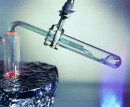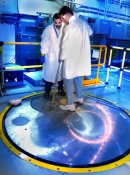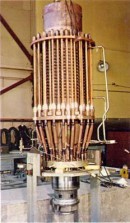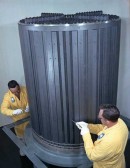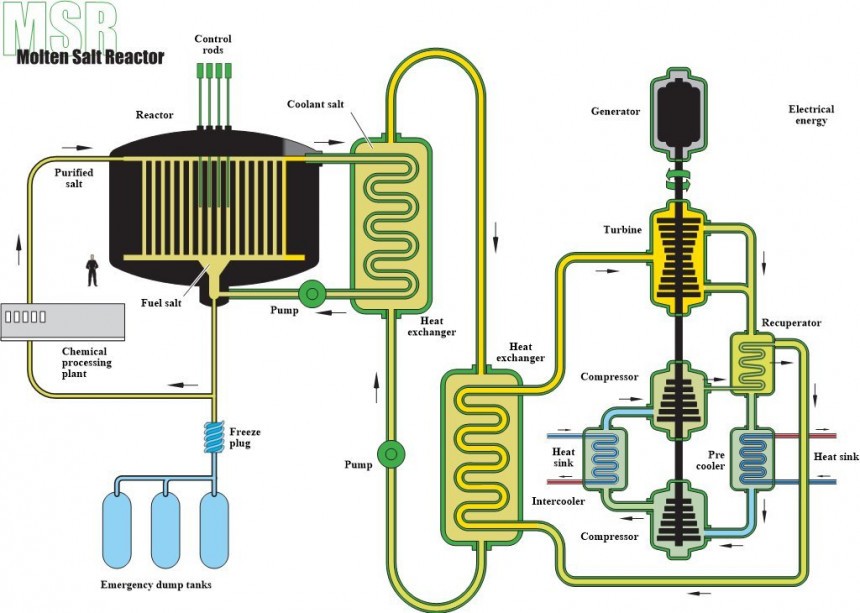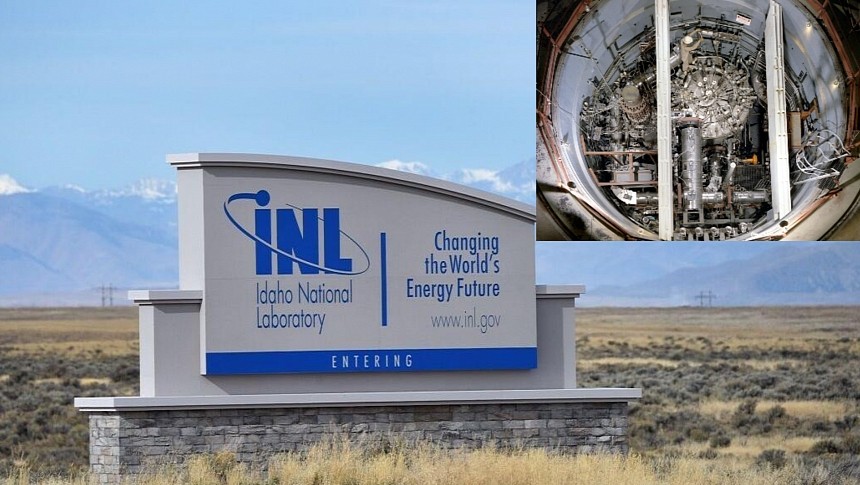
Photo: Idaho National Laboratory (Outer Image)/ Oak Ridge National Laboratory (Inner Image)
America desperately needs to un-learn a few myths about nuclear energy we've come to learn from the Simpsons and the HBO adaptation of Chernobyl. But even so, a recent experiment proposal by two American nuclear energy research firms and the U.S. Department of Energy (DOE) has the global atomic community up in arms. Let's cut to the chase; it's a proposal to conduct experiments with what's effectively weapons-grade uranium.
But before you panic and write letters to your governors, let's take a deep dive into companies and U.S. agencies involved in this controversial experiment. A report by Reuters from May 30th, 2023, details how the U.S. DOE and two separate domestic energy contractors, one of which is backed by Bill Gates, intend to use the grounds at the Idaho National Laboratory in Idaho Falls as the site of a radical new fission reactor experiment. With help from the electric utility firm Southern Co and the engineering firm TerraPower LLC, run by the above-mentioned archetypal tech billionaire, the DOE intends to make great strides in a little-researched but potentially lucrative type of nuclear reactor.
Dubbed the Molten Chloride Reactor Experiment (MCRE), the DOE hopes to build the next generation of molten-salt-based nuclear reactors which use a super-heated salt solution instead of water and graphite to cool the fissile uranium isotope within the mixture, as well as moderate the neutrons, flung off from continuous critical fission and keeping the reaction at a steady, controllable rate. Only twice before has this bizarre, almost fictitious-sounding brand of fission reactor been studied in a research setting before. In both instances, these reactors were housed at the Oak Ridge National Laboratory in Tennesee.
TerraPower's novel molten-chloride fast reactor (MCFR) was first commissioned with a cost-share award from the DOE worth more than $40 million in 2016. It shares a similar operating principle to that of the twin molten-salt reactors at Oak Ridge. Indeed, a consortium of scientists and engineers from Oak Ridge Labs themselves are a part of the team committed to bringing TerraPower's MCFR to Idaho. But it's the DOE's proposal to use up to 600 kg (1,322 lbs) of uranium-235 isotope enriched by up to 93 percent.
When uranium ore is extracted and refined into a highly enriched form commonly called "yellow cake," the material is almost equally suited to building a bomb as it generates loads of useable electricity. For this reason, it's no wonder that even a group of retired nuclear energy watchdogs submitted a letter to the DOE urging them to reconsider the proposed MCFR experiment. "The damage to national security could exceed any potential benefit from this highly speculative energy technology," the letter read, as per Reuters' report.
"It is shocking that the Energy Department, without even notifying the public, would undermine a decades-old, bipartisan U.S. policy to prevent the spread of nuclear weapons." As per the same report, the DOE retorted these claims, hailing highly-enriched uranium as the only means of keeping the overall size of the Molten Chloride Reactor Experiment from becoming too vast. But it's not hard to understand why the upsides of weapon's grade uranium, such as smaller reactor facilities with larger, more unwieldy reactor vessels, don't match up to the considerable downsides.
Even an announcement by TerraPower themselves, stating that the MCRE enriched uranium would not be replicated in commercial reactors, did little to quell fears that nations such as Iran, North Korea, or China, ramping up their own uranium enrichment programs while using moves made in the West as a precedent. In light of the now-defunct Iranian-American arms deal, which prevented the Iranians from using enriched uranium for use in nuclear weapons, such brazen use of the material by U.S. companies on private research projects could send a message to global powers to start adding to their own global supplies.
In a world where around 12,500 nuclear warheads exist between the U.S., Russia, China, and a few other nations, this latest news on the U.S. domestic energy front paints a dubious picture behind TerraPower's intentions to use enriched uranium. From a certain perspective, it's almost like Bill Gates and Co knew that using enriched uranium in a research reactor would cause quite a stir and yet continued lobbying for its use via the Department of Energy regardless. What this means for the Molten Chloride Reactor Experiment, or even whether it'll make its way to Idaho Falls at all, remains to be seen.
In the meantime, only the Chinese are working on another molten-salt fast reactor project via the TMSR-LF1 thorium-based experimental reactor. Unlike TerraPower's adaptation of similar technology, the TMSR-LF1 reactor utilizes relatively stable thorium as its fissile fuel instead of enriched uranium. Though Chinese state media's decreed the sight will be operational by February 2023, no such announcement has yet been made official as of June 2023. This means, at least for the current moment, humanity's ambitions for a molten-salt-based nuclear reactor remain tantalizingly out of reach.
Dubbed the Molten Chloride Reactor Experiment (MCRE), the DOE hopes to build the next generation of molten-salt-based nuclear reactors which use a super-heated salt solution instead of water and graphite to cool the fissile uranium isotope within the mixture, as well as moderate the neutrons, flung off from continuous critical fission and keeping the reaction at a steady, controllable rate. Only twice before has this bizarre, almost fictitious-sounding brand of fission reactor been studied in a research setting before. In both instances, these reactors were housed at the Oak Ridge National Laboratory in Tennesee.
TerraPower's novel molten-chloride fast reactor (MCFR) was first commissioned with a cost-share award from the DOE worth more than $40 million in 2016. It shares a similar operating principle to that of the twin molten-salt reactors at Oak Ridge. Indeed, a consortium of scientists and engineers from Oak Ridge Labs themselves are a part of the team committed to bringing TerraPower's MCFR to Idaho. But it's the DOE's proposal to use up to 600 kg (1,322 lbs) of uranium-235 isotope enriched by up to 93 percent.
When uranium ore is extracted and refined into a highly enriched form commonly called "yellow cake," the material is almost equally suited to building a bomb as it generates loads of useable electricity. For this reason, it's no wonder that even a group of retired nuclear energy watchdogs submitted a letter to the DOE urging them to reconsider the proposed MCFR experiment. "The damage to national security could exceed any potential benefit from this highly speculative energy technology," the letter read, as per Reuters' report.
Even an announcement by TerraPower themselves, stating that the MCRE enriched uranium would not be replicated in commercial reactors, did little to quell fears that nations such as Iran, North Korea, or China, ramping up their own uranium enrichment programs while using moves made in the West as a precedent. In light of the now-defunct Iranian-American arms deal, which prevented the Iranians from using enriched uranium for use in nuclear weapons, such brazen use of the material by U.S. companies on private research projects could send a message to global powers to start adding to their own global supplies.
In a world where around 12,500 nuclear warheads exist between the U.S., Russia, China, and a few other nations, this latest news on the U.S. domestic energy front paints a dubious picture behind TerraPower's intentions to use enriched uranium. From a certain perspective, it's almost like Bill Gates and Co knew that using enriched uranium in a research reactor would cause quite a stir and yet continued lobbying for its use via the Department of Energy regardless. What this means for the Molten Chloride Reactor Experiment, or even whether it'll make its way to Idaho Falls at all, remains to be seen.
In the meantime, only the Chinese are working on another molten-salt fast reactor project via the TMSR-LF1 thorium-based experimental reactor. Unlike TerraPower's adaptation of similar technology, the TMSR-LF1 reactor utilizes relatively stable thorium as its fissile fuel instead of enriched uranium. Though Chinese state media's decreed the sight will be operational by February 2023, no such announcement has yet been made official as of June 2023. This means, at least for the current moment, humanity's ambitions for a molten-salt-based nuclear reactor remain tantalizingly out of reach.



